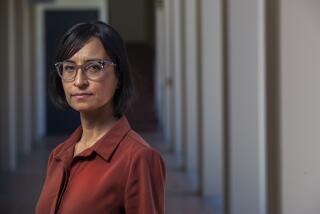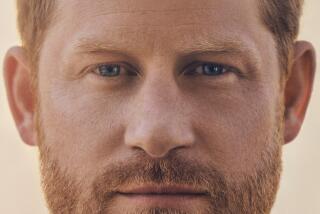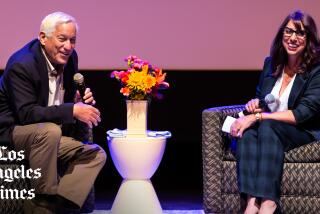Q&A: Mona Awad on her sharp-voiced debut, ’13 Ways of Looking at a Fat Girl’
Veronica Tartley’s intense, caustic columns for the Montreal-based “Maisonneuve Magazine” (i.e., Defunct Pixie Dust: Disneyland for adults) quickly garnered a following. Eventually, the pseudonym slipped away, and behind the sharp and entertaining observations, stood Mona Awad, a real, live writer from Canada.
Awad’s satiric edge is on display in her debut novel in stories, “13 Ways of Looking at a Fat Girl” (Penguin Books: 224 pp., $16 paper). Its main character, Lizzie, grapples with body image and weight loss in a book whose humor masks darker truths.
Awad — who attended Brown and studied in Scotland, worked at a bookstore in Utah and is now getting her PhD in creative writing and English literature at the University of Denver — spoke to us by phone. This interview has been edited for length and clarity.
This novel constantly flips between two views — the interior, or the way that Lizzie sees herself, and the exterior — the way that people engage or interact with her. There’s a sense that Lizzie is an outsider even when she’s a part of a group.
As a reader and as a writer, I’m interested in characters that occupy an in-between place in the world. They’re outsiders in some way, and they don’t really have a definitive sense of home. I think there are infinite possibilities to explore when there’s some ambiguity in terms of claiming an identity or being part of a group.
My father was from Egypt and my mother was French Canadian, but they sent me to an English-speaking Catholic school so I saw some of these interior/exterior moments in the way that people interacted with me growing up. I think that all of those different facets of my storytelling interests definitely got explored in “13 Ways.” It informed how I approached depicting Lizzie’s interiority — her character. The feeling of being out of place, of both craving attention and wanting to be invisible, of constantly comparing herself to others.
Music permeates and perhaps even drives certain stories in this collection. How did you find the emotional pulse for these vignettes? Who were some of the artists that you listened to?
I made playlists for every chapter/story. I would never listen to the playlists while I was writing, but I would listen to them at certain times — while I was cooking dinner or something like that — to really immerse myself in the world and time of a story to help me access it.
At certain times, I needed Nina Simone’s urgency. … There’s a desperation that’s really beautiful in her singing and in her lyrics, and that always resonated with me and it felt particularly potent while I was working.
I listened to a lot of the Rolling Stones, especially for “My Mother’s Idea of Sexy.” I listened to a lot of jazz when I was writing “If That’s All There Is.” People like Chet Baker, a lot of Peggy Lee, Coltrane … some Miles Davis.
I love Charles Bradley. I’ve seen him live a couple of times. I love artists who put everything on the line when they’re performing and when they sing, and that’s why Charles Bradley and Nina Simone resonate. That approach to music is the kind of approach I was trying to take in my writing; it made me braver in my writing to listen to those people. Nina Simone made me feel brave, kind of fearless.
When I was working on the first story, “When We Went Against the Universe,” there was more rock and goth, and I was listening to Nick Cave, London After Midnight, Peter Murphy, The Velvet Underground.
Let’s talk about the goth element in this book: Arguably it’s a fusion of the interior perspective with the exterior, music and culture. Why that avenue?
The gothic subculture is one that I don’t think gets explored a lot in literature, and as a writer and as a person who is interested in art in the 1980s … I felt like it would be very fitting to kind of go in that direction. The goth music is what Lizzie’s best friend loved, and Lizzie tends to be a reflector of whatever is around her or she tries to be.
Goth and the industrial movement at the time when Lizzie is growing up is very subterranean and very anti-establishment. For somebody like Lizzie, who kind of sees herself outside, as marginal and underground to some extent, that subculture appeals to her, and there is a kind of innate acceptance in it. My friends and I always joked that goth is the last resort of “cool” for nerds. We totally included ourselves in that category.
There’s also a punishing aspect to the culture, to goth’s aesthetic. I think it’s very rigid to some degree, or at least it was — the fashion and in terms of the look and the types of bodies that are hailed as the ultimate. Every subculture has a type of body and a kind of fashion that’s associated with it.
[The character] China is kind of emblematic of that ... of the goth body that both Lizzie and Mel really want. They get the music. They’re neck-deep in the music, but China has the body, the look, and that’s just absolutely what makes her, in Lizzie’s mind, so momentous. Lizzie’s magical thinking about China is what sets up the first hopes for transformation from her current state.
Lizzie often looks to these female friendships for some type of fairy-tale type transformation, which sets up some interesting tensions, especially around body image.
I’m particularly interested in just how complicated female friendships can be, how fraught, and I think that side of friendship is worth exploring. I think body image is something that comes between women and shapes the dynamic between them, and that was something I really wanted to blow up in this book. It was something I really wanted to examine closely. I wanted to understand how friends influence the way that we see ourselves and the way that we are in the world, the way we feel about our bodies and the way we interact.
I wanted to examine the circumstances around the girl who thinks she’s fat and the girl who is confident in her slenderness. There’s this kind of magical thinking that’s going on for Lizzie. She believes she gets her photo taken by the girl who is slender and perceived to be beautiful. … She’s hoping it will allow her to look through a lens and make her beautiful to be looked at through a lens. … There’s something so heartbreaking in that, twisted in that, hopeful in that. It’s something that I think is very reflective of Lizzie’s overall state of mind.
Let’s talk about the body image issue that’s the center of this book. ... There were a couple of lines that punched me in the gut because they felt so real. Where does that come from?
Body image is something I struggled with, and while this is a work of fiction, I was very committed to portraying Lizzie with as much emotional honesty as I could — really committing to her way of seeing herself and the kind of damage that uneasy, uncertain, internalized isolation can do. So I went all the way with it.
I really wanted to dig into those moments of tension between herself and the mirror, herself and her friends, herself and her lovers, herself and a dress, herself and a meal, where that body image struggle was really rearing its head. I wanted to zoom in and recount her experience moment to moment.
I know that at the University of Edinburgh, your area of study included fairy tales — specifically fear in fairy tales. How does that play into this collection?
I think there’s a subverted fairy tale there. In fairy tales, ultimately the narrative is usually one of transformation, and usually in most tales that we read now, that transformation resolves with a happy ending. I wanted to complicate that.
While I was interested in the transformational aspect of it, in our own desire for that kind of transformation, I also wanted to trouble of it and leave it in a different place.
I felt like in that moment — the moment in the dressing room — she’s naked and she’s looking into the mirror and she’s under these bright lights and she’s also in public. It was a way to explore how women feel about their bodies and all the complicated stuff that comes up — the anxieties, the desires, the hopes, the feelings of rage, the feelings of humiliation, all of those things.
You go in there and it’s fraught, because you go in there and part of you hopes to be transformed by the clothing, by that experience, into something more beautiful. It’s a very vulnerable experience, and it can be a very dreadful experience. You have to reckon with your body in a way that you don’t in any other place.
She keeps going back to the dressing room partly out of necessity, but she keeps going back also because she wants to be transformed. She’s hoping that changing in these dressing rooms will turn her into this perfect woman that she’s portrayed herself to be, but only if she’s able to fit into smaller and smaller sizes.
Latria Graham (@LGRaconteur) is a freelance writer based in South Carolina. Her work as appeared in Ebony Magazine, The New York Times and The Guardian.
More to Read
Sign up for our Book Club newsletter
Get the latest news, events and more from the Los Angeles Times Book Club, and help us get L.A. reading and talking.
You may occasionally receive promotional content from the Los Angeles Times.






